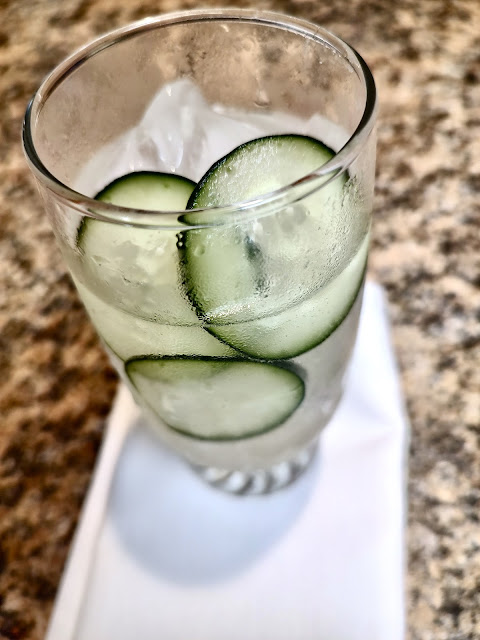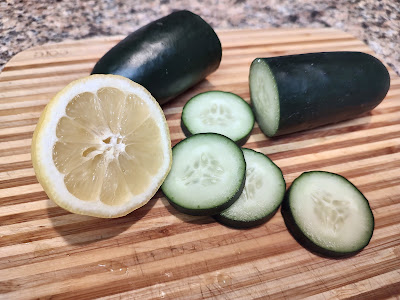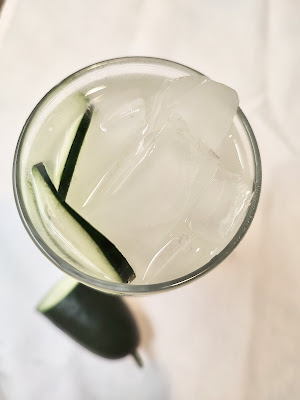
Recipe: White Linen cocktail with fresh cucumber and lemon
 |
|
The White Linen cocktail was invented in Sacramento.
(Photos: Debbie Arrington) |
Is cucumber and lemon really the taste of Sacramento? The combination is undoubtedly refreshing and fills this cocktail with both flavor and fragrance.
Debuting during Sacramento’s 2008 Cocktail Week, the White Linen has been getting a lot of buzz lately. The New York Times featured it as the “signature cocktail of Sacramento.” Raley’s announced it will be marketing a pre-made White Linen mix.
Invented by mixologist Rene Dominguez of Ella’s Dining Room and Shady Lady Saloon, the White Linen starts with dry gin. Dominguez recommends Hendrick’s, which has a cucumber note to its base. Elderflower liqueur (such as St. Germain) adds hints of pear and elderberry. (Although those are French elderflowers used in St. Germain, elderberry is native to the Sierra foothills and grows well in Sacramento, so that’s anther nod to its hometown.)
Cucumbers and lemon add summery bursts of flavor. Cutting up the cucumber and giving it a good long shake muddles the veggie and releases its flavor into the gin. The result is a very sophisticated, grown-up cucumber-lemonade; kind of like cucumber water with a kick.
Does it taste like Sacramento? You be the judge.
 |
| Cucumber and lemon: How refreshing! |
White Linen cocktail
Makes 2 servings
Ingredients:
½ fresh cucumber
1 lemon
2 tablespoons simple syrup* or powdered sugar
3 ounces (2 jiggers) dry gin
1 ounce (2 tablespoons) elderflower liqueur
Ice
Sparkling water
Instructions:
Slice six thin slices of cucumber for garnish; set aside. Chop the remaining cucumber into 1/2-inch pieces.
Juice lemon. To the juice, add simple syrup or powdered sugar. Mix to dissolve.
 |
| Toast midsummer with a White Linen. |
Fill a cocktail shaker halfway with ice. Add the gin, elderflower liqueur, lemon mixture and chopped cucumber. Cover and shake 15 to 30 seconds.
Fill two tall glasses with ice. Pour mixture through strainer over ice, equally dividing between glasses. Add sparkling water and stir. Add reserved cucumber slices as garnish. Serve immediately.
* To make simple syrup: In a small saucepan, dissolve ½ cup sugar in ½ cup water. Bring to boil and boil 1 minute. Let cool before using. Store in refrigerator.
Easy variation: Substitute Sprite for sparkling water. Omit simple syrup or powdered sugar. Result is more citrus-y.
Comments
0 comments have been posted.Sacramento Digs Gardening to your inbox.
Sites We Like
Garden Checklist for week of April 14
It's still not warm enough to transplant tomatoes directly in the ground, but we’re getting there.
* April is the last chance to plant citrus trees such as dwarf orange, lemon and kumquat. These trees also look good in landscaping and provide fresh fruit in winter.
* Smell orange blossoms? Feed citrus trees with a low dose of balanced fertilizer (such as 10-10-10) during bloom to help set fruit. Keep an eye out for ants.
* Apply slow-release fertilizer to the lawn.
* Thoroughly clean debris from the bottom of outdoor ponds or fountains.
* Spring brings a flush of rapid growth, and that means your garden needs nutrients. Fertilize shrubs and trees with a slow-release fertilizer. Or mulch with a 1-inch layer of compost.
* Azaleas and camellias looking a little yellow? If leaves are turning yellow between the veins, give them a boost with chelated iron.
* Trim dead flowers but not leaves from spring-flowering bulbs such as daffodils and tulips. Those leaves gather energy to create next year's flowers. Also, give the bulbs a fertilizer boost after bloom.
* Pinch chrysanthemums back to 12 inches for fall flowers. Cut old stems to the ground.
* Mulch around plants to conserve moisture and control weeds.
* From seed, plant beans, beets, cantaloupes, carrots, corn, cucumbers, melons, radishes and squash.
* Plant onion sets.
* In the flower garden, plant seeds for asters, cosmos, celosia, marigolds, salvia, sunflowers and zinnias.
* Transplant petunias, zinnias, geraniums and other summer bloomers.
* Plant perennials and dahlia tubers for summer bloom.
* Mid to late April is about the last chance to plant summer bulbs, such as gladiolus and tuberous begonias.
* Transplant lettuce seedlings. Choose varieties that mature quickly such as loose leaf.